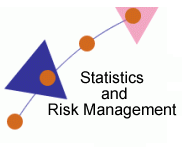
Risk Management Strategies
Statistics & Risk Management
Rather than just 'rolling the dice', good risk management strategies in business are determined by the ability to identify and asses the elements associated with uncertainty.
There are four main strategies involved in risk management.
Involves removing a hazard, engaging in a alternative activity or avoiding a specific exposure for the business
Also known as risk mitigation, risk reduction is a systematic decrease in the extent of exposure to a risk or the possibility of its occurance
Shifting one risk to another such as purchasing insurance
Basically the opposite of transference which means the organization accepts the total amount of the risk instead of insuring it

Let's take a company trying to cover its risk with insurance as an example. Using insurance is a classic example of risk management. Insurance companies can provide businesses with a wide array of commercial property and casualty insurance products. All businesses face a multitude of risks in their day-to-day activities. A toy manufacture will want to cover itself by adding insurance that will help if a customer has a child that chokes on a product. A farmer may want to insure against a frost that could kill his crops. Or a web hosting company may want insurance against outages or hackers trying to steal confidential data or bring down a site entirely. These are all examples of the types of decisions that are involved in insuring against and managing risk.